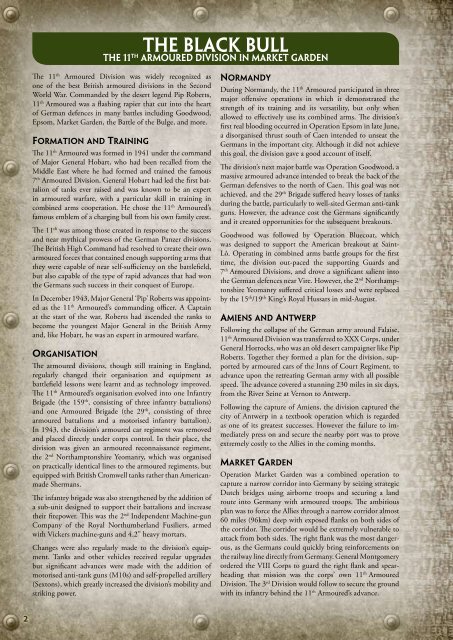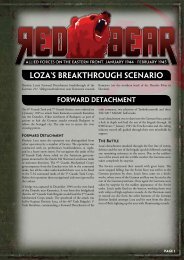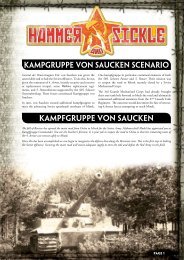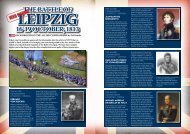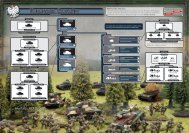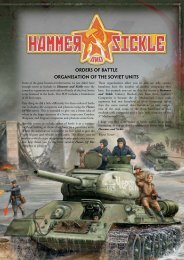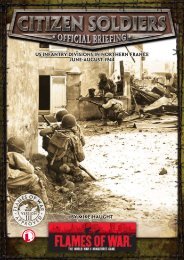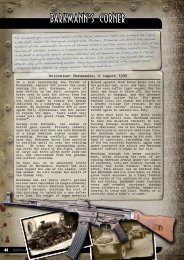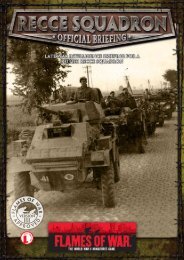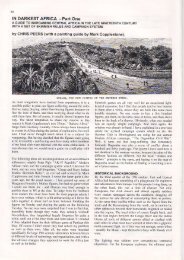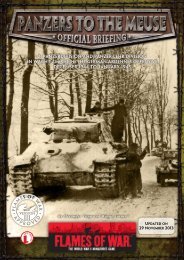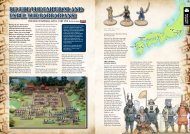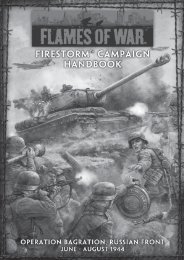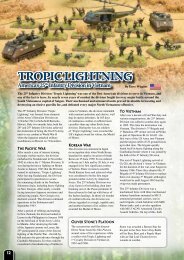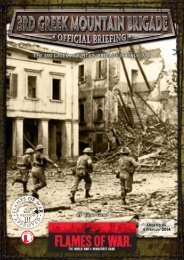By Jason Davis, Tom McBride, James Huff, and ... - Flames of War
By Jason Davis, Tom McBride, James Huff, and ... - Flames of War
By Jason Davis, Tom McBride, James Huff, and ... - Flames of War
You also want an ePaper? Increase the reach of your titles
YUMPU automatically turns print PDFs into web optimized ePapers that Google loves.
The Black Bull<br />
The 11 th Armoured Division in Market Garden<br />
The 11 th Armoured Division was widely recognized as<br />
one <strong>of</strong> the best British armoured divisions in the Second<br />
World <strong>War</strong>. Comm<strong>and</strong>ed by the desert legend Pip Roberts,<br />
11 th Armoured was a flashing rapier that cut into the heart<br />
<strong>of</strong> German defences in many battles including Goodwood,<br />
Epsom, Market Garden, the Battle <strong>of</strong> the Bulge, <strong>and</strong> more.<br />
Formation <strong>and</strong> training<br />
The 11 th Armoured was formed in 1941 under the comm<strong>and</strong><br />
<strong>of</strong> Major General Hobart, who had been recalled from the<br />
Middle East where he had formed <strong>and</strong> trained the famous<br />
7 th Armoured Division. General Hobart had led the first battalion<br />
<strong>of</strong> tanks ever raised <strong>and</strong> was known to be an expert<br />
in armoured warfare, with a particular skill in training in<br />
combined arms cooperation. He chose the 11 th Armoured’s<br />
famous emblem <strong>of</strong> a charging bull from his own family crest.<br />
The 11 th was among those created in response to the success<br />
<strong>and</strong> near mythical prowess <strong>of</strong> the German Panzer divisions.<br />
The British High Comm<strong>and</strong> had resolved to create their own<br />
armoured forces that contained enough supporting arms that<br />
they were capable <strong>of</strong> near self-sufficiency on the battlefield,<br />
but also capable <strong>of</strong> the type <strong>of</strong> rapid advances that had won<br />
the Germans such success in their conquest <strong>of</strong> Europe.<br />
In December 1943, Major General ‘Pip’ Roberts was appointed<br />
as the 11 th Armoured’s comm<strong>and</strong>ing <strong>of</strong>ficer. A Captain<br />
at the start <strong>of</strong> the war, Roberts had ascended the ranks to<br />
become the youngest Major General in the British Army<br />
<strong>and</strong>, like Hobart, he was an expert in armoured warfare.<br />
organisation<br />
The armoured divisions, though still training in Engl<strong>and</strong>,<br />
regularly changed their organisation <strong>and</strong> equipment as<br />
battlefield lessons were learnt <strong>and</strong> as technology improved.<br />
The 11 th Armoured’s organisation evolved into one Infantry<br />
Brigade (the 159 th , consisting <strong>of</strong> three infantry battalions)<br />
<strong>and</strong> one Armoured Brigade (the 29 th , consisting <strong>of</strong> three<br />
armoured battalions <strong>and</strong> a motorised infantry battalion).<br />
In 1943, the division’s armoured car regiment was removed<br />
<strong>and</strong> placed directly under corps control. In their place, the<br />
division was given an armoured reconnaissance regiment,<br />
the 2 nd Northamptonshire Yeomanry, which was organised<br />
on practically identical lines to the armoured regiments, but<br />
equipped with British Cromwell tanks rather than Americanmade<br />
Shermans.<br />
The infantry brigade was also strengthened by the addition <strong>of</strong><br />
a sub-unit designed to support their battalions <strong>and</strong> increase<br />
their firepower. This was the 2 nd Independent Machine-gun<br />
Company <strong>of</strong> the Royal Northumberl<strong>and</strong> Fusiliers, armed<br />
with Vickers machine-guns <strong>and</strong> 4.2” heavy mortars.<br />
Changes were also regularly made to the division’s equipment.<br />
Tanks <strong>and</strong> other vehicles received regular upgrades<br />
but significant advances were made with the addition <strong>of</strong><br />
motorised anti-tank guns (M10s) <strong>and</strong> self-propelled artillery<br />
(Sextons), which greatly increased the division’s mobility <strong>and</strong><br />
striking power.<br />
norm<strong>and</strong>y<br />
During Norm<strong>and</strong>y, the 11 th Armoured participated in three<br />
major <strong>of</strong>fensive operations in which it demonstrated the<br />
strength <strong>of</strong> its training <strong>and</strong> its versatility, but only when<br />
allowed to effectively use its combined arms. The division’s<br />
first real blooding occurred in Operation Epsom in late June,<br />
a disorganised thrust south <strong>of</strong> Caen intended to unseat the<br />
Germans in the important city. Although it did not achieve<br />
this goal, the division gave a good account <strong>of</strong> itself.<br />
The division’s next major battle was Operation Goodwood, a<br />
massive armoured advance intended to break the back <strong>of</strong> the<br />
German defensives to the north <strong>of</strong> Caen. This goal was not<br />
achieved, <strong>and</strong> the 29 th Brigade suffered heavy losses <strong>of</strong> tanks<br />
during the battle, particularly to well-sited German anti-tank<br />
guns. However, the advance cost the Germans significantly<br />
<strong>and</strong> it created opportunities for the subsequent breakouts.<br />
Goodwood was followed by Operation Bluecoat, which<br />
was designed to support the American breakout at Saint-<br />
Lô. Operating in combined arms battle groups for the first<br />
time, the division out-paced the supporting Guards <strong>and</strong><br />
7 th Armoured Divisions, <strong>and</strong> drove a significant salient into<br />
the German defences near Vire. However, the 2 nd Northamptonshire<br />
Yeomanry suffered critical losses <strong>and</strong> were replaced<br />
by the 15 th /19 th King’s Royal Hussars in mid-August.<br />
amiens <strong>and</strong> antwerp<br />
Following the collapse <strong>of</strong> the German army around Falaise,<br />
11 th Armoured Division was transferred to XXX Corps, under<br />
General Horrocks, who was an old desert campaigner like Pip<br />
Roberts. Together they formed a plan for the division, supported<br />
by armoured cars <strong>of</strong> the Inns <strong>of</strong> Court Regiment, to<br />
advance upon the retreating German army with all possible<br />
speed. The advance covered a stunning 230 miles in six days,<br />
from the River Seine at Vernon to Antwerp.<br />
Following the capture <strong>of</strong> Amiens, the division captured the<br />
city <strong>of</strong> Antwerp in a textbook operation which is regarded<br />
as one <strong>of</strong> its greatest successes. However the failure to immediately<br />
press on <strong>and</strong> secure the nearby port was to prove<br />
extremely costly to the Allies in the coming months.<br />
market garden<br />
Operation Market Garden was a combined operation to<br />
capture a narrow corridor into Germany by seizing strategic<br />
Dutch bridges using airborne troops <strong>and</strong> securing a l<strong>and</strong><br />
route into Germany with armoured troops. The ambitious<br />
plan was to force the Allies through a narrow corridor almost<br />
60 miles (96km) deep with exposed flanks on both sides <strong>of</strong><br />
the corridor. The corridor would be extremely vulnerable to<br />
attack from both sides. The right flank was the most dangerous,<br />
as the Germans could quickly bring reinforcements on<br />
the railway line directly from Germany. General Montgomery<br />
ordered the VIII Corps to guard the right flank <strong>and</strong> spearheading<br />
that mission was the corps’ own 11 th Armoured<br />
Division. The 3 rd Division would follow to secure the ground<br />
with its infantry behind the 11 th Armoured’s advance.


